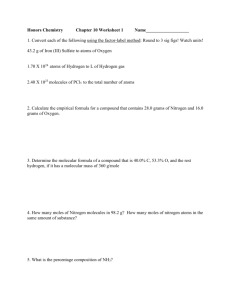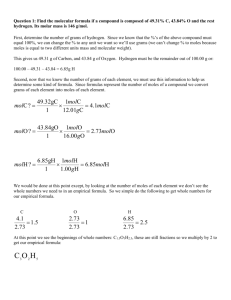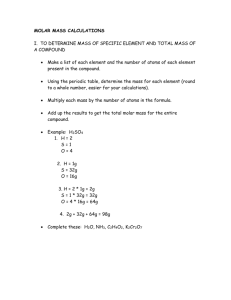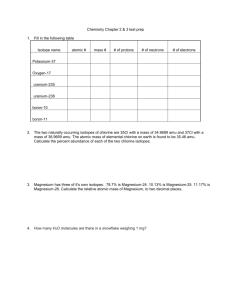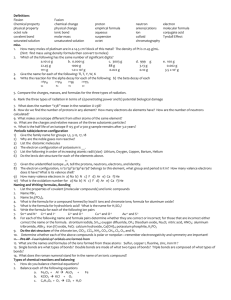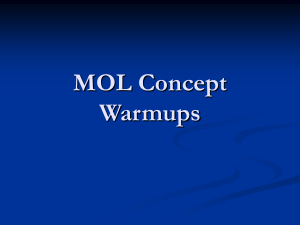CHEMISTRY - END OF YEAR FINAL EXAM 2013 UNIT 4
advertisement
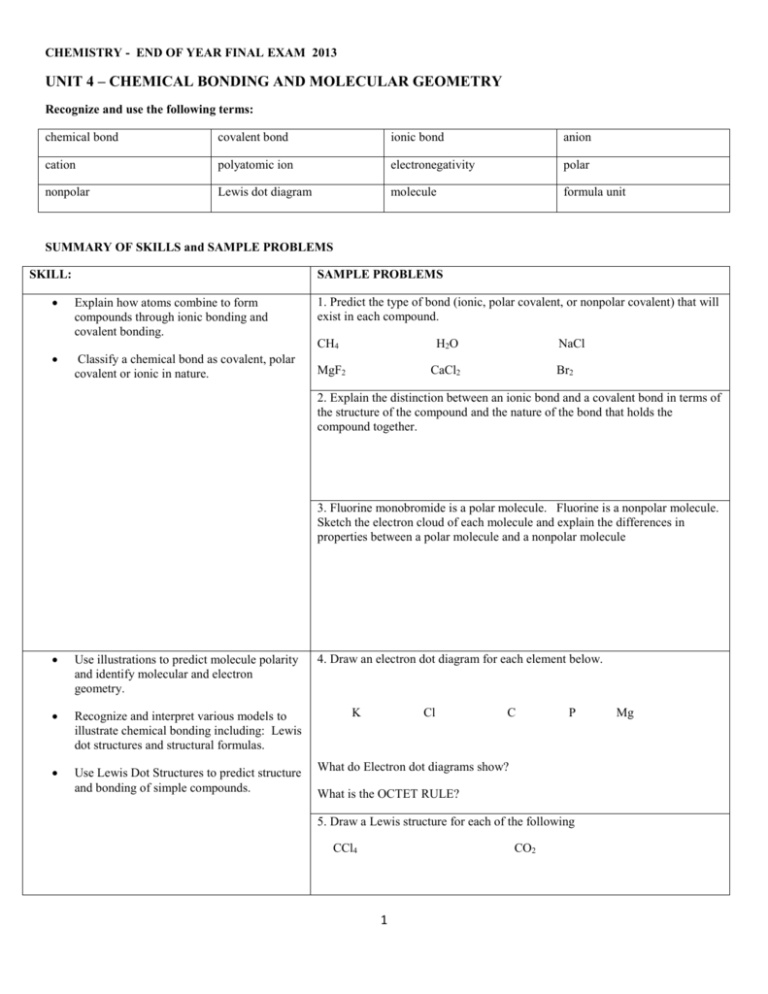
CHEMISTRY - END OF YEAR FINAL EXAM 2013 UNIT 4 – CHEMICAL BONDING AND MOLECULAR GEOMETRY Recognize and use the following terms: chemical bond covalent bond ionic bond anion cation polyatomic ion electronegativity polar nonpolar Lewis dot diagram molecule formula unit SUMMARY OF SKILLS and SAMPLE PROBLEMS SKILL: SAMPLE PROBLEMS Explain how atoms combine to form compounds through ionic bonding and covalent bonding. Classify a chemical bond as covalent, polar covalent or ionic in nature. 1. Predict the type of bond (ionic, polar covalent, or nonpolar covalent) that will exist in each compound. CH4 H 2O MgF2 CaCl2 NaCl Br2 2. Explain the distinction between an ionic bond and a covalent bond in terms of the structure of the compound and the nature of the bond that holds the compound together. 3. Fluorine monobromide is a polar molecule. Fluorine is a nonpolar molecule. Sketch the electron cloud of each molecule and explain the differences in properties between a polar molecule and a nonpolar molecule Use illustrations to predict molecule polarity and identify molecular and electron geometry. Recognize and interpret various models to illustrate chemical bonding including: Lewis dot structures and structural formulas. Use Lewis Dot Structures to predict structure and bonding of simple compounds. 4. Draw an electron dot diagram for each element below. K Cl C P What do Electron dot diagrams show? What is the OCTET RULE? 5. Draw a Lewis structure for each of the following CCl4 CO2 1 Mg Models of bonding continued… NH3 H2O 6. For each of the structures above predict the SHAPE/GEOMETRY of the molecule. Which of these molecules will be POLAR? Which is likely to dissolve in water? Determine Molecular and Ionic Formulas for compounds. Apply IUPAC nomenclature to name molecular and ionic compounds. 7. Name each compound. Ionic compounds: CaCl2 Ca3(PO4)2 FeCl2 NaOH NH4NO3 Na2SO4 8. Covalent compounds CBr4 SO N2P3 BCl3 AsF5 P4O10 9. Write the formula of each compound Ionic Compounds: Barium chloride Ammonium carbonate Calcium Fluoride Sodium Sulfite Sodium oxide Potassium hydroxide Covalent Compounds Iodine monochloride sulfur triiodide selenium dichloride diphosphorus pentoxide 2 Unit 5A- Chemical Reactions VOCABULARY: Be able to recognize, define, and use the following terms. Formula Mass Molecular Mass Molar Mass Mole Molecular Formula Empirical Formula SKILLS AND SAMPLE PROBLEMS Skill Calculate the formula mass of a compound given formula and/or name. Avagadro’s Number Percent Composition Example Problem(s) 10 NaCl __________ PbSO4________________ Potassium nitrate _________ ___________ Be able to differentiate between a molecule and an ionic compound Convert moles of a given substance to number of particles and vice versa Carbon tetrachloride ________ ____________ 11 Carbon monoxide _______________ Sodium chloride_________________ Tin (IV) oxide ____________________ Ammonia ___________________ 12. 10 moles of sulfur trifluoride 3.2 mole iron (II) oxide 5.25 x 1023 molecules of water Use molar mass to convert grams to moles of a substance and vice versa 6.19 x 1030 formula units of sodium chloride 13 100.4 grams of sulfur trifluoride 3.20 grams iron (II) oxide 5.25 moles of water Calculate the percent composition by mass given of the elements in a compound 6.19 moles of sodium chloride 14. Laboratory procedures show that 50.0 grams of ammonia, NH 3 , yields 41.0 grams of nitrogen and 9.00 grams of hydrogen upon decomposition. What is the percent composition of ammonia? The decomposition of 25.0 grams of Ca(OH)2 in the lab produces 13.5 grams of calcium, 10.8 grams of oxygen, and 0.68 grams of hydrogen. What is the percent composition of calcium hydroxide? Calculate the percent composition by mass, given the formula or name of a compound 15. BF3 Ca(C2H3O2)2 FeF3 Reduce molecular formulas to empirical formulas 16. What is the empirical formula for C8H18 ? What is the empirical formula for C6H6 ? What is the empirical formula for WO2 ? 3 Determine the empirical formula of a compound given either percent composition or masses 17. The percent composition of a compound as 40.0% carbon, 6.71% hydrogen, and 53.3% oxygen. THE EMPIRICAL FORMULA POEM – easy way to remember the steps in this approach… % to mass Mass to mol Divide by small Multiply ‘til whole Decomposing a substance to its elemental parts yields 40.0 grams of carbon, 6.71 grams of hydrogen, and 53.3 grams of oxygen. What is the empirical formula? A sample of pure indium chloride with a mass of 0.5000 grams is found to contain 0.2404 grams of chlorine. What is the empirical formula of this compound? Determine the molecular formula of a compound given either the percent composition and molar mass or masses 18. Find the molecular formula for a compound with percent composition of 40.0% carbon, 67.1% hydrogen, and 53.3% oxygen. The molecular mass of the compound is 180 g/mol. A compound has the empirical formula C2H8N and a molar mass of 46 g/mol . What is the molecular formula of this compound? A compound has the empirical formula C2H4NO . If its molar mass is 116.1 g/mol , what is the molecular formula of the compound. Unit 5B- The Mole Concept Chemical Reaction Balanced Chemical Equation Combustion Reaction Single Replacement Reaction Products Coefficient Decomposition Reaction Synthesis Reaction SKILLS: Things you should be able to do Explain what happens during a chemical reaction Identify the reactant and products in a chemical reaction Reactant Subscript Double Replacement Reaction Hydrocarbon 19. Cu(s) +AgNO3(aq) Cu(NO3)2(aq) + Ag(s) HCl(aq)+NaOH(aq) NaCl(aq) + H2O(l) Convert verbal descriptions of chemical reactions into chemical equation and vice versa 20. Solid calcium metal is placed in liquid water to produce aqueous calcium hydroxide and hydrogen gas. Aqueous sodium hydroxide is mixed with gaseous chlorine to produce aqueous solutions of sodium chloride and sodium hypochlorite plus liquid water. H2SO4(aq)+NaCN(aq) HCN(aq) + Na2SO4(aq) 20 continued... Fe(s) + O2(g) Fe2O3(s) 4 Use common symbols (s), (l), (g), (aq) and 21. Solid copper reacts with an aqueous solution of silver nitrate to produce a solution of copper(II) nitrate and solid silver. Explain the roles of subscripts and coefficients in chemical equations 22. H2SO4(aq) + Al(OH)3(aq) Al2(SO4)3(aq) + H2O(l) Write a balanced chemical equation when given the unbalanced equation 23. H2SO4(aq) + Al(OH)3(aq) Al2(SO4)3(aq) + H2O(l) Ba(NO3)2(aq) +Na2CO3(aq) BaCO3(aq) +NaNO3(aq) Explain the role of the law of conservation of mass in a chemical reaction 24. Fe(NO3)3 + 3 NaOH Fe(OH)3 + 3 NaNO3 Mass of the Reactant Side: Product Side Mass: Describe what is occurring in synthesis, decomposition, single replacement, double replacement, or combustion reactions 25. Classify a chemical reaction as synthesis, decomposition, single replacement, double replacement, or combustion reactions 26.____ NaBr + ____ H3PO4 ____ Na3PO4 + ____ HBr Type of reaction: ____________________ ____ Ca(OH)2 + ____ Al2(SO4)3 ____ CaSO4 + ____ Al(OH)3 Type of reaction: ____________________ ____ Mg + ____ Fe2O3 ____ Fe + ____ MgO Type of reaction: ____________________ ____ C2H4 + ____ O2 ____ CO2 + ____ H2O Type of reaction: ____________________ ____ PbSO4 ____ PbSO3 + ____ O2 Type of reaction: ____________________ Predict the products of simple reactions 27. ____ NH3 + ____ I2 Type of reaction: ____________________ ____ H2O + ____ SO3 Type of reaction: Synthesis ____ H2SO4 + ____ NH4OH Type of reaction: ____________________ 5 UNIT 6 – STOICHIOMETRY Recognize and use the following terms: reactant product mole ratio coefficient formula unit limiting reactant/reagent excess reactant/reagent theoretical yield actual yield percent yield SKILL: SAMPLE PROBLEMS Interpret chemical equations in terms of molecules, formula units, and moles 28.Balance each, then determine how many moles/molecules/formula units of each reactant and each product? H2O2 O2 + H2O AgNO3 + Cu --> Cu(NO3)2 + Ag Calculate moles of a reaction component given moles of another reaction component (mole to mole problems). 29. H2SO4 + 2NaOH Na2SO4 + H2O - If reaction completely consumes 4 moles of NaOH, how many moles of sodium sulfate will be produced? 2H2 + O2 2H2O If 6 moles of oxygen react with excess hydrogen, how many moles of water are produced? Calculate the mass of a reaction component given the mass of another reaction component (mass to mass problems). 30. Ba(OH)2 + HNO3 --> Ba(NO3)2 + H2O In the above unbalanced reaction, if the 1.67g of barium hydroxide is completely reacted with an excess of nitric acid, how many grams of water will be produced? 4Fe (s) + 3O2(g) --> 2Fe2O3 In the above reaction, if 5.88g of iron (III) oxide is produced, how many grams of iron were needed? Be able to use a given volume of a gaseous reaction component to find the moles, or mass of another reaction component. Or given a mass or molar amount of a reaction component, calculate the volume of a gaseous reaction component. 31. C2H4(g) + 3O2(g) --> 2CO2(g) + 2H2O(g) If the above combustion reaction consumes 2.43L of oxygen, how many liters of carbon dioxide will be produced? If the above reaction consumes 34.7g of ethene (C2H4), how many liters of water vapor will be produced? (GAS STOICHIOMETRY) Determine Limiting and/or excess reactant in a reaction given masses or moles of reactants. Determine the mass of an excess reactant left over in a reaction. 32. CaO(s) + SiO2(s) CaSiO3(s) Calcium silicate can form from the reaction of calcium oxide with silicon dioxide as shown in the balanced equation above. What is the limiting reagent when 89.2 g of CaO reacts with 120.8 g of SiO2? What is the theoretical yield of calcium silicate product in the above reaction? Calculate the percent yield of a chemical process given the actual yield of the reaction and sufficient information to calculate the theoretical yield. Determine the mass of excess reagent in the above reaction. 33. Use your theoretical yield from the above problem. If a chemist does the reaction with the masses of reactants given above, and finds an actual yield of 154.4g of calcium silicate, calculate the % yield of the reaction. 6


